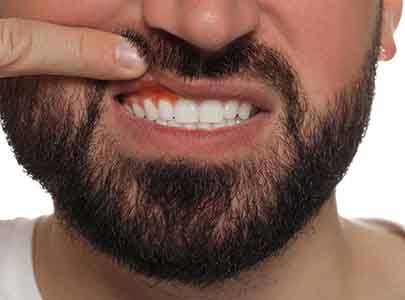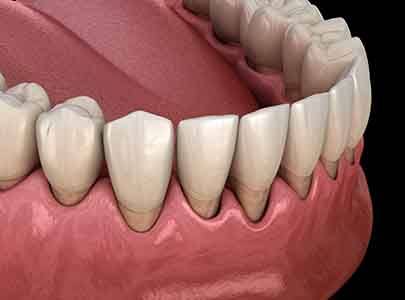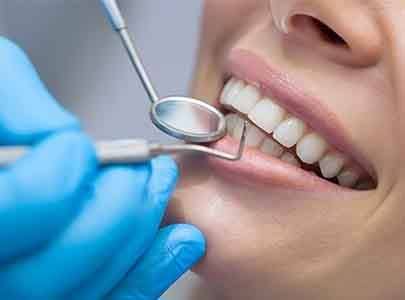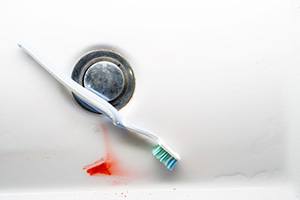Gum Disease Treatment – Cary, NC
Keeping Your Gums Free of Infection
While many don’t realize it, nearly half of American adults have a severe form of gum disease. This condition starts relatively mild, but eventually, it can destroy the tissue that keeps your teeth attached to your jaw, leading to tooth loss. When an infection in your gums has become too advanced to treat with a simple cleaning, you can count on Dr. Singh to provide you with effective gum disease treatment in Cary, NC, that could save your smile. Contact us today if you think your gums need special attention.
Why Choose Cary Dental Rejuvenation for Gum Disease Treatment?
- Soft Tissue Lasers Used for a More Comfortable Treatment
- Thorough Deep Cleaning Above and Below Gumline
- A Caring, Appreciative Dentist
What is Gum Disease?

When bacteria attack the gums, they become infected. Bleeding and inflammation are often the initial signs of gingivitis, which is the first stage of gum disease. If caught early, the symptoms can be reversed by practicing good oral hygiene at home and attending regular cleanings with our dental team. If left untreated, though, the infection can spread, resulting in periodontitis. It is at this point that gum disease can negatively affect more than just your mouth. It can also play a role in health-related conditions developing throughout the body.
Symptoms of Gum Disease

While bleeding and inflammation may be the first signs you notice, others can go undetected or be dismissed if you are unsure what to look for. Dr. Singh is highly qualified to be able to check for the signs of gum disease during a checkup, but you can take a more proactive approach if you notice any of the following before your appointment:
- Your teeth appear longer than before (gum recession)
- Your teeth no longer come together as cohesively as before
- You notice that one or more of your teeth are loose
- You’ve developed bad breath
- Your gums feel more tender
How Do We Treat Gum Disease?

At Cary Dental Rejuvenation, Dr. Singh will first examine your mouth using state-of-the-art dental technology to determine the severity and extent of the infection. Once he builds a treatment plan, he will discuss the available services and decide which one is right for you.
Antibiotic Therapy

Even after a deep cleaning, there might still be some bacteria in your mouth that could contribute to an infection in your gums. That’s why we’ll often make antibiotics a part of your periodontal therapy. At Cary Dental Rejuvenation, we’ll locally apply a medication called ARESTIN® to any pockets that have formed in your gums as a result of gum disease. This way, it can help get rid of bacteria and encourage the mouth to heal at a faster rate.
Scaling & Root Planing

The deep cleaning procedure typically used to treat gum disease is divided into two major phases: scaling and root planing. Scaling is the process of cleaning bacteria, plaque, tartar, and general debris off the surface of your teeth as well as around and below the gumline. Once that is done, we perform root planing to smooth out the roots of your teeth, helping them reattach to the gums and effectively stopping the disease’s progression.
Do I Need Scaling & Root Planing?

You might need scaling and root planing if you notice symptoms of gum disease, such as:
- Red, swollen, and puffy gums.
- Persistent bad breath that does not go away when you brush and floss.
- Gum recession.
- Visible plaque buildup along your gumline.
- Easy bleeding when you brush or floss.
In some cases, the earliest stages of gum disease can be reversed via thorough at-home oral hygiene. In other cases, scaling and root planing is necessary. Our team can let you know which option is best in your case.
The Process of Scaling & Root Planing

Scaling and root planing is a two-part procedure:
- During scaling, we use an instrument known as a scaler to scrape plaque and tartar off the teeth. We also reach into the gum pockets in order to clean below the gumline.
- During root planing, we smooth out the roots of the teeth so it is more difficult for bacteria to stick to them.
Depending on how much of your mouth requires treatment, scaling and root planing may require multiple appointments.
Aftercare Tips for Scaling & Root Planing

Scaling and root planing can cause some gum tenderness and soreness. It might be a few weeks before your gums recover. In the meantime, here are some tips to minimize your discomfort:
- Regularly rinse your mouth with warm salt water.
- Eat soft foods that are not too hot.
- Be gentle when performing oral hygiene. Be sure to use a soft-bristled toothbrush.
- Avoid strenuous physical activity for the first few days after your procedure.
Gum Disease FAQs
What are the Health Risks of Gum Disease?
Aside from its initial symptoms, gum disease also carries some long-term health risks. You’ll want to keep these in mind as you manage your infection.
Most of the major risks develop when gum disease becomes severe. At that point, a patient is likely to suffer permanently damaged gums, jawbone loss, and even tooth loss. Their infection is also linked to a higher risk of heart attacks, strokes, diabetes, certain cancers, and more. As for these latter conditions, bacteria from infected gums can enter your bloodstream and trigger harsh health problems.
To minimize the risks above, you should immediately see your dentist for treatment. Their help will keep your gum disease from causing too much trouble.
Is Gum Disease a Dental Emergency?
Gum disease technically isn’t a dental emergency, at least not in the same way a lost tooth is. Still, you should have a dentist treat it as soon as possible.
Note that gum disease doesn’t go away on its own. As the infection takes root in your gums, its bacteria will further harm your smile and cause serious health effects. Leaving it alone would do severe damage to your smile, your jaw, and the rest of your body.
Thankfully, you can always visit our office for care. We’ll quickly schedule your treatment, address your infection, and help you avoid (or manage) gum disease’s side effects.
Is Damage from Gum Disease Permanent?
Whether your gum disease causes permanent damage will depend on its severity. The longer it goes untreated, the more likely its effects will become irreversible for you.
Just look at gingivitis, for example. This early form of gum disease can be treated and even reversed with prompt intervention. In that case, you could make your gums as healthy and strong as before.
In contrast, periodontitis - advanced gum disease - isn't so fixable. This condition can only be managed at best, so its damage is permanent and irreversible. The most you could do is get gum grafts or dental implants to partially treat its gum recession and tooth loss.
Will My Gum Disease Reoccur?
Your gum disease could reoccur if you're not careful in the post-treatment phase. Given that fact, we'll advise you to get frequent cleanings in the months after your initial procedure. These extra cleansing sessions will keep bacteria from further harming your gum tissues.
As for ways to prevent reinfection at home, you could do the following:
- Brush your teeth twice daily with a soft-bristled toothbrush and tartar-controlled toothpaste.
- When flossing at night, use high-quality dental floss to clean between each tooth and around the gum line.
- See your dentist for checkups and cleanings at least twice a year.
- Avoid smoking and drinking, as these habits can trigger gum disease.
